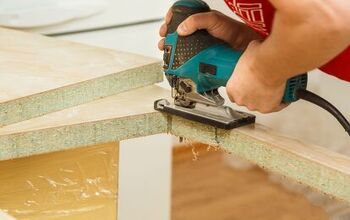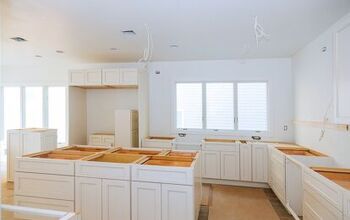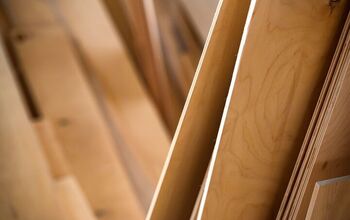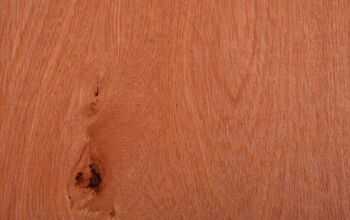What Kind Of Plywood For A Shed Floor? (Find Out Now!)

When I first started writing for Upgraded Home, one of my first articles was about “she sheds.” She sheds are sheds that are made to be a woman’s lounge area in the garden. When you are making your own little shed hideaway, you need to make sure to use the right materials. This includes choosing the right kind of plywood for your shed floor. But, what should you use for flooring?
The best type of plywood for a typical shed floor would be 3/4 inch thick CDX pressure-treated plywood. Pressure-treated plywood is meant to be better for load-bearing than standard plywood, and also can withstand moisture better than typical exterior plywood. Moreover, it’s still affordable because it’s made from C and D-grade plywood.
Choosing the right type of plywood can make the difference between having to patch up a hole in your floor and having to stick to worrying about how you want to organize your shed. This guide will explain what to expect.
Do You Need to Hire a Framing Contractor?
Get free, zero-commitment quotes from pro contractors near you.

Can You Use Plywood For A Shed Floor?
Most shed floors are made out of plywood, but not all plywood is going to be worth making a floor from. Plywood has a great knack for being able to carry large loads without tiring and for being affordable. However, some types of plywood don’t hold up well with exposure to moisture. Since you are making a floor for an area that is going to be exposed to the elements, you should choose a moisture-resistant type.
What Alternatives To Plywood Can You Use For A Shed Floor?
There are a couple of other alternatives that people tend to look towards. The most common is to choose a concrete slab that acts as a floor, but that’s pricey. Other common alternatives include decking board and oriented strand board. These can often be harder to install, so it’s generally smarter to stick to plywood whenever possible.
What Are The Most Common Types Of Plywood To Use For A Shed Floor?
Though there is a standard thickness for plywood of 3/4 inch, the truth is that you still have a couple of options for the specific type that you use on a shed floor. These are the most commonly recommended types that you can use:
- CDX Exterior Plywood. As the name suggests, this is a type of plywood that is often used on exterior structures. While it is moisture-resistant up to a point, the truth is that it’s not entirely moisture-proof. This is still a fairly good option, as long as you treat it with a waterproofing sealant. In areas like Arizona, you might not need to worry about waterproofing at all.
- CDX Pressure-Treated Plywood. This is a good option for people who are focused on longevity. This is almost identical to exterior plywood with one little difference: it’s treated to be more water-resistant. If you live in an area that is famous for mold and high humidity, this is an investment that you need to consider.
- Marine Plywood. Without a doubt, this is the most expensive of the bunch and often doesn’t really make sense in most cases. However, marine plywood might be a better option if you live in an area that has near-constant moisture and flooding. This is specially-treated plywood that is meant for constant exposure to moisture. For example, if you live in the Everglades, you might want to use this type of wood.
Can You Use Cabinet-Grade Plywood For A Shed Floor?
Here’s the thing that many people tend to forget about cabinet-grade plywood: it’s mostly a grading that’s all about looking pretty. Cabinet-grade plywood is meant to be a “display” plywood that looks good. While it is strong enough to hold up a human’s weight and then some, using it for a shed floor doesn’t really make a lot of sense financially.
Unless you are looking to make a chiquer she shed that feels like a luxury cottage, the truth is that you don’t need to have pretty flooring in a shed. The flooring that you are putting in will take a lot of abuse from all the heavy machinery and crap that you are going to be storing there. So, why break the bank just to have a nicer floor? Most people would consider it a waste of money.
Do You Need to Hire a Framing Contractor?
Get free, zero-commitment quotes from pro contractors near you.

Related Questions
What is the most durable material for a shed floor?
Though most people tend to use plywood for their shed flooring, the truth is that it’s not the most durable material for the flooring of your shed. If you want to get the most durable material for a shed floor, then you will need to look for a reinforced concrete slab. Concrete is pure, unadulterated stone.Since it is made out of stone, you will be able to ensure that you will be able to use that flooring for decades to come. This is also the best type of material if you want to house extremely heavy machinery in your shed.
What type of OSB can be used to create a shed floor?
OSB is a good choice if you want to have a more “interior-style” floor for your shed. The easiest one to install is going to be a tongue-and-groove type of flooring. These use interlocking panels to keep moisture out and make installation a cinch. This is a good choice if you want to avoid plywood but still want to be able to enjoy the benefits of wood flooring. It can get somewhat expensive though, so keep that in mind.
What is better for shed flooring, OSB or plywood?
If you want to take the advice of both the National Tile Contractors Association and the Resilient Floor Covering Institute, then you will try to stick to plywood. It’s seen as the more durable and workable material of the two. OSB is seen as a decent floor choice, though it is still second to plywood due to its difficulty with moisture. When in doubt, ask a flooring expert to help you pick out the right choice for your shed.

Ossiana Tepfenhart is an expert writer, focusing on interior design and general home tips. Writing is her life, and it's what she does best. Her interests include art and real estate investments.
More by Ossiana Tepfenhart



























